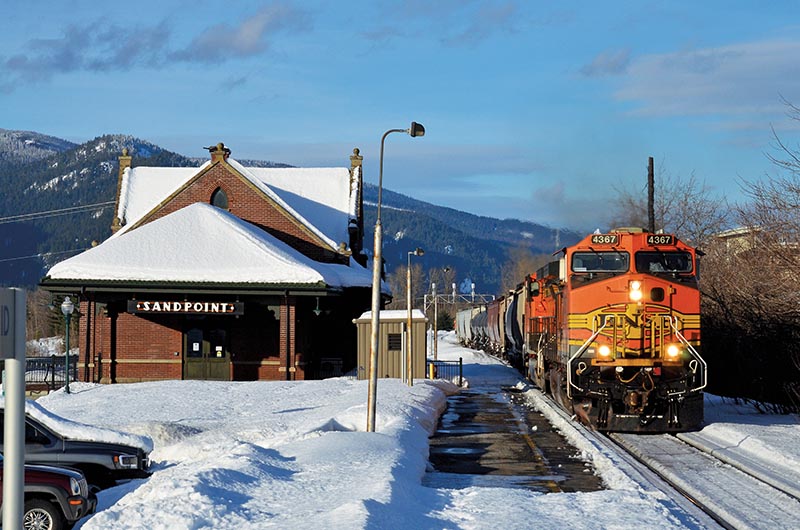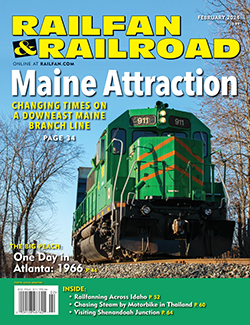 By Steve Jessup/photos as noted
By Steve Jessup/photos as noted
So what’s the big advantage of living in southern Idaho versus northern Idaho? “Not as much snow,” a gentleman from the bank said. “I don’t have to shovel all that stuff anymore.”
Finding a place to live, and certainly finding more affordable housing, is another reason why the Boise (Treasure Valley) region is one of the fastest-growing areas in the country. People from California, especially, are moving to the cities of Meridian, Boise, Nampa, and Caldwell in droves.
But railroading is not on the list of southern Idaho attractions. Even railfans admit that following Union Pacific here is of little interest. Stretching some 400 miles from the Oregon-Idaho border to the Idaho-Wyoming border, this main line that once handled around 20–25 freights a day sees just over half that nowadays. The locomotive variety is a far cry from the old days. However, if you like wide-open, dusty, western scenery in your viewfinder, perhaps this will be a consolation to your relocation plans.
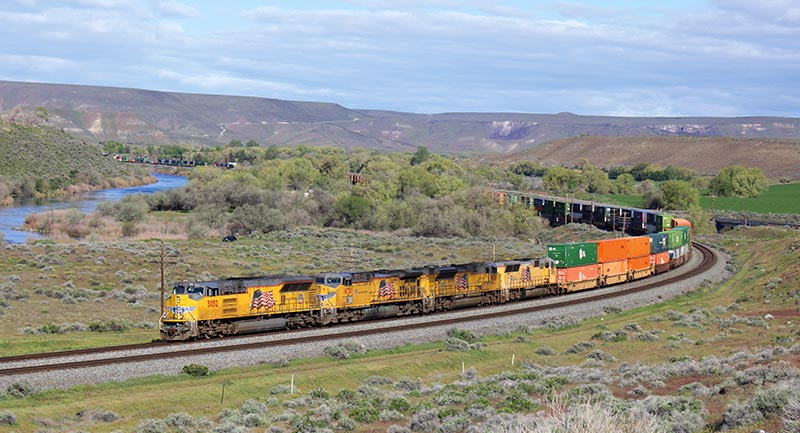
ABOVE: Sweeping around the curve at King Hill is a hot Seattle–Chicago “Z train” led by Union Pacific SD70ACe-T4 3052. It’s a very cold spring morning on May 7, 2022, and this will be the second of only four trains that will pass here through the rest of the afternoon. —Steve Jessup photo
While you may choose southern Idaho as the place to hunker down, you will undoubtedly visit the panhandle numerous times — the forested hills and mountains; the streams and lakes; the trails, back roads, wildlife, and small towns; the trains. Wait, trains?
Yes, this is where Union Pacific’s rival BNSF Railway plays hot and heavy. From Sandpoint south, there’s almost four times as much daily traffic on this main as there is on Uncle Pete’s Huntington and Nampa subdivisions way south. Throw in a half-dozen or more UP Spokane International freights to and from Eastport on the Canadian border, and you have more than enough reason to pursue your trackside adventures. From a railroading standpoint, the contrast is striking — like day and night. BNSF versus UP. High traffic versus low traffic. Lush green mountains and meadows versus brown, dry, open spaces. Scenery around every corner versus tumbleweeds blowing across the plains. I know where I’d rather be. But for the sake of this presentation, we’ll serve up a slice of both sides in this tale of two Idahos.
Southern Idaho
Home for me is the Treasure Valley in southern Idaho. This region and Ada County are anchored by Boise, the state capital and home to some 240,000 residents. Add in the neighboring cities of Meridian, Nampa, and Caldwell, plus smaller communities, and the population is nearly half a million.
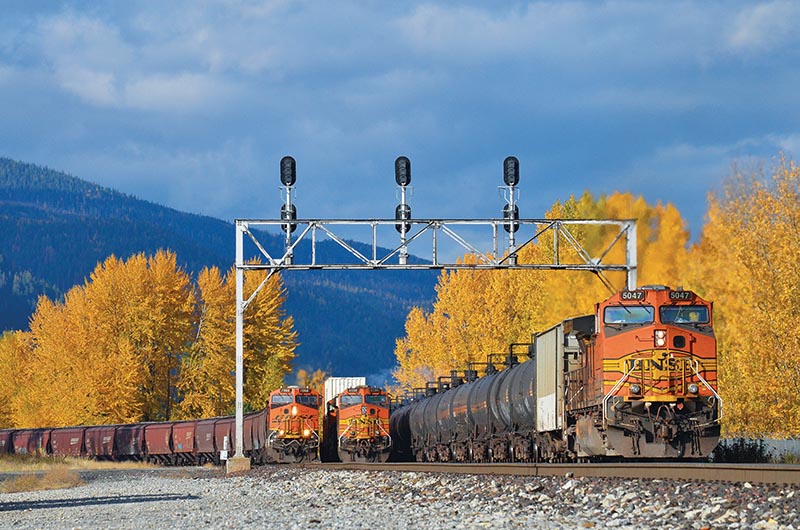
ABOVE: Fall rush on “The Funnel” finds golden trees flanking multi-train action on October 22, 2016. At right, an empty oil train with DPU 5047 diverges from BNSF onto Montana Rail Link at Sandpoint Junction. At left, a grain with BNSF 7068 on the point will soon get the signal to proceed past the Sandpoint depot. It will be followed by a stack train (middle) with 4138 leading. —Bruce Kelly photo
On the western side of the state, Nampa holds down its namesake subdivision while Pocatello does the same on the eastern side. The Pocatello Subdivision runs east from there out to Granger, Wyo., where it connects to UP’s Cheyenne–Salt Lake City main. Then there’s the Montana Sub reaching from Pocatello to Silver Bow, Mont. From Nampa westward, the Huntington Sub runs to Ontario, Ore., but comes back into Idaho for a stretch before exiting the state for good farther northwest in the Snake River Canyon.
When our family moved here in 2019, our usual train watching spot was a park in Caldwell. Double track westward out of Nampa Yard ended here, so the signals provided all the indications we needed for traffic. I should point out that the park is a terrific spot to kill dead time. Wiffle ball was absolutely necessary with my daughter.
At the time we arrived in the region, UP was running about 20 trains per day, but precision scheduled railroading (PSR) was on the brink of consuming every Class I railroad. And because of that, traffic has disappeared. Union Pacific has reported more than once that its northwest main line (from Granger to Portland, Ore., and Seattle) has much less traffic and fewer crews than most of its mains across the country. That isn’t good news for those of us who want to regularly capture our subjects.
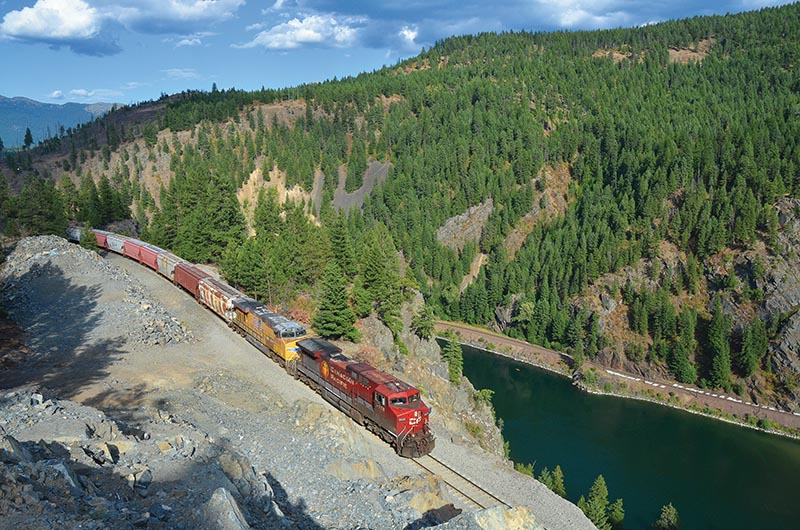
ABOVE: Some 400 feet above the Kootenai River, Union Pacific Train OETLV descends the 1 percent grade between Moyie Springs and Bonners Ferry on July 19, 2015. The train, led by Canadian Pacific AC4400 9625, is carrying export potash bound for Longview, Wash. BNSF Railway’s ex-Great Northern line is visible on the opposite side of the river. —Bruce Kelly photo
As PSR took hold, those wiffle ball stints continued to get longer between trains. Seeing maybe five to seven freights in five hours in 2019 turned into perhaps one or two trains in the same amount of time. A Saturday visit to Glenns Ferry and King Hill in 2022 netted just four trains in eight hours. And a recent move to a trackside location gave me opportunity to log traffic. In some cases, it was not a pretty picture.
While it’s possible to run into two or three freights in one location, a better strategy might be to find a single train and shoot it at multiple spots. I like variety, so just one freight is aggravating, but sometimes you have to maximize the minimum. Looking around for a good spot when you’re ahead of the train will yield some good results. I found this out one day while roaming around Glenns Ferry and King Hill. The spring green image of 3052 leading a UP Z train is my favorite on this line so far…


